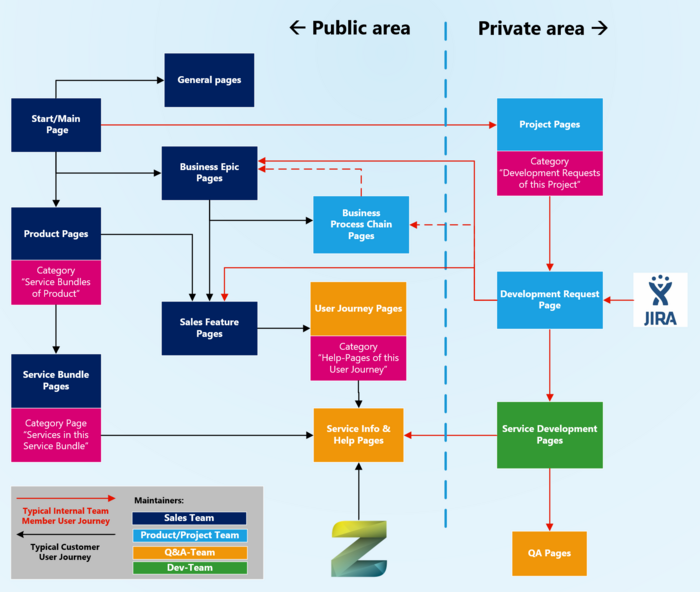Basic structure of this wiki
The Start/Main Page presents the user an overview of all content and refers to the product pages. From there the user can navigate to various General Pages (like this one) which provide information on ZUGSEIL or the ZUGSEIL products.
Product Pages
Each product offered by ZUGSEIL has its own Product Page, which is category page of all bop service bundles offered by ZUGSEIL as part of the product described in this page. In the content section of the category page, more information on the product is provided:
- a description of the product
- the target audiences of the product
- a list of all sales features each linking to a sales feature page. “sales” means that only features are listed here worth mentioning to the customer. If a user of the wiki wants to find a full overview on what services are part of the product, he has to browse over the service bundle pages with their contained services.
- Similar products and feature comparison.
The Product Pages are maintained by the Sales Team.
Business Epic Pages
A Business Epic Page contains a description of an area of business from a customer`s perspective. It is mostly meant to be a advertising text describing problems in this business area and puts the software features our products offer in this area in a context of the entire area and links their Software Feature pages.
An epic page is typically structured with these content-sections:
- general description of the business area
- descriptions of problems in this area and how these problems are solved by our Software Features (each with links to Software Feature Pages)
Each Business Epic Page also serves as Category Page for all Business Processes covered by our Features.
Examples for Business Epics are:
- Internal Ordering
- Sourcing & Procurement
- Warehousing
- Fulfillment
The Product Pages are maintained by the Product Management Team.
Software Feature Pages
Each feature enabled by a product has its own Software Feature Page. It is a category page of all user journeys enabled by this feature.
A Software Feature is a set of functionality, which is defined by business processes it covers. A Software Feature Page describes this functionality from the user managers perspective. The page focuses on the business case and value it provides (savings, automation level, ...) but not on the business processes on a detailed level.
Each of these Feature Pages typically contains:
- a general description of the business case the feature is enabling together with high level business process chains affected by the software feature
- a business value description for the customer ("What value does it deliver for me?")
- a list of all business processes required for delivering Software Feature (without description, but with a link to the dedicated business process page).
Each Software Feature Page also serves as Category Page for the User Journeys possible by this Software Feature.
Examples for a Feature are:
- Regular Internal Ordering
- Laundry Site Services
Business Process Pages
A Business Process Page provides a detailed description of a business process from its start to its end. They are closely linked to User Journey Pages, but describe the business process in an abstract business process engineering manner.
The Business Process Page contains information on:
- a reference workflow of this business process (without providing screenshots). This description should be linked to User Journey Pages to enable the user how the coverage of this business process will look alike when he is using our software.
- a description of each step of the entire process. This description should be linked to User Help Pages, where individual pages are explained.
- possible variations of the process and reference to all software features which require this business process to operate.
The information should be not from the technical view but rather from the business and user perspective so that a person reading this page understands which value can be generated from our software to his processes.
Examples for Business Process Pages are:
- Assisted Ordering for a team member
- Laundy Bring-In at a Laundry-Shop
User Journey Pages
Each task the user wants to complete should have User Journey Page. The name of a User Journey Page typically starts with "How can I ... ". Each user journey page also is a category page, to which all Service Help Pages are linked which the user needs to visit, operate or use during the described user journey.
A User Journey Page contains these information:
- Exact description of the task to be demostrated by this user journey
- Step-by-step explanation of what to do (click through-explanation or even video)
Examples for User Journey Pages are:
- How can I get a quick overview of my orders?
- How can I add a product to an entitlement?
Depending on the task of the user, the referencing user journeys can eventually span over multiple services and multiple business processes.
Service Help Page
Service Bundle Pages
Service Pages
This page has three main sections:
- A header section, marked by <nowiki bop="basicServiceInfo"/>. It contains generic information like service-type, Service-veservice-description,
- The first section holds information on what the user can achieve with it. This part is Also it holds the configuration options and an explanation of these
- The configuration section
- The release history section
- The compatibility section, which is autogenerated
Available types are:
- App - Full window applications
- Dashboard widget - Apps which can be placed
- Configration options
User Help Pages
